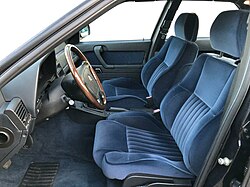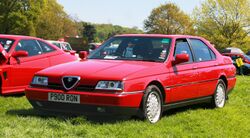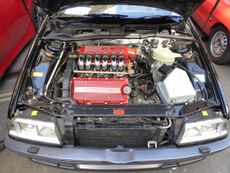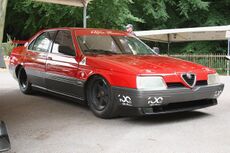Engineering:Alfa Romeo 164
| Alfa Romeo 164 | |
|---|---|
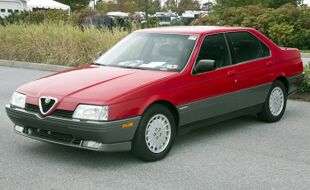 | |
| Overview | |
| Manufacturer | |
| Also called | Alfa Romeo 168 (Hong Kong and Malaysia) |
| Production | 1987–1998 |
| Assembly | Italy: Arese Plant, Lombardy |
| Designer | Enrico Fumia at Pininfarina[1] |
| Body and chassis | |
| Class | Executive car (E) |
| Body style | 4-door saloon |
| Layout | Front-engine, front-wheel-drive / four-wheel-drive |
| Platform | Type Four[2] |
| Related |
|
| Powertrain | |
| Engine | |
| Transmission | |
| Dimensions | |
| Wheelbase | 2,660 mm (104.7 in) |
| Length |
|
| Width | 1,760 mm (69.3 in) |
| Height |
|
| uk|uk|Kerb|Curb}} weight | 1,200–1,510 kg (2,650–3,330 lb) |
| Chronology | |
| Predecessor | |
| Successor | Alfa Romeo 166 |
The Alfa Romeo 164 (Type 164) is a four-door executive saloon manufactured and marketed by Italian automaker Alfa Romeo from 1987 to 1998, styled by Pininfarina, and cooperatively designed and sharing platforms and numerous elements with the Fiat Croma, Saab 9000 and Lancia Thema.
Predecessors of the 164 were the Alfa 90 and the luxurious Alfa 6. The 164 was followed by the 166 in 1998, after a combined production total of 273,857 units.[3]
Development
In October 1978, Alfa Romeo, Fiat, Lancia and Saab jointly agreed to each develop an executive saloon based on their shared Type Four platform ("Tipo 4" in Italian), to eventually compete against the likes of the Ford Granada and Opel Rekord (Vauxhall Carlton) as well as more premium saloons by BMW and Mercedes-Benz in the form of the 5 Series and E-Class, respectively.
Project 164 started life as Project 156 (not to be confused with Alfa Romeo 156) and was completed in 1981, then still under Alfa Romeo. A year later, that project morphed into the 164 based on the Type Four platform.[4] The new model was styled by Enrico Fumia of Pininfarina,[5] with a wedge shape yielding it a drag coefficient of 1px;">d=0.30. The design would later influence the rest of the Alfa Romeo range (starting in 1990 with the major redesign of the 33 and culminating with the 155.
Ultimately unveiled at the 1987 Frankfurt Motor Show, the 164 was the last model to be developed while the Alfa Romeo was still a fully independent company, and was formally launched a few months after the takeover by Fiat.
Design
Enrico Fumia of Pininfarina was responsible for the 164 design, with the first 1:1 scale model produced in 1982.[6] Design cues were publicly revealed on the Alfa Romeo Vivace concept car, which was exhibited at the 1986 Turin Motorshow that went on to influence the design of the Alfa Romeo GTV and Spider (916 series) launched in 1994.[7]
The 164 became the first Alfa to benefit from extensive use of computer aided design, used to calculate structural stresses that resulted in a very rigid but still relatively lightweight chassis. Although sharing the same platform as that of the Lancia Thema, Fiat Croma and Saab 9000, by virtue of the fact that it was the last of the four to enter production, it featured unique front suspension geometry and the most distinctive styling of the lot. In fact, for example, the other cars all shared identical side door panels. Though still voluminous, the 164 had the tightest aperture to the rear boot, which had a 510-Litre capacity.
Overall, the 164 also benefitted from improved build quality relative to previous Alfas, due to the extensive use of galvanised steel for the frame and various body panels for the first time in the brand's history. Moreover, the car featured advanced (but troublesome)[8] electronics because of the most complex wiring harness fitted to any Alfa Romeo. For example: it had three onboard computers (one for air conditioning, one for instrumentation, and one for the engine management); air conditioning and instrument functions shared a multiple-mode coded Zilog Z80-class microcontroller for dashboard functioning). The instrumentation included a full range of gauges including an advanced check-panel.
Its interior was spacious and modern, available with standard velour seating or leather trim depending on the model. Its dashboard continued the avantgarde design of the exterior with a centre console that was dominated by a large number of seemingly identical buttons arranged in rows. Air-direction within the ventilation system was controlled by a pair of servomechanisms, which used fragile plastic gears.[citation needed]
Depending on the model, the 164 featured automatic climate control and electronically controlled damping suspension - the latter, for example, in the sports-oriented Quadrifoglio Verde ("Green Cloverleaf ") and 164S models. This suspension actively reduced damping in response to conditions to provide a dynamic compromise between road holding and comfort.
Range
The 164 was offered as a 4-door saloon, unlike the related Type Four cars that were available in other bodystyles (i.e. Croma and 9000 hatchback; 9000 and Thema sedans; Thema wagon). In addition, until 1993, the 164 was only available in front wheel drive like the related cars.
The original 164 range launched in 1987 comprised the following models:[9]
- 2.0i Twin Spark (badged "T.SPARK")
- 2.0 Turbo (four-cylinder, Italian market only)
- 3.0i V6 12-valve
- 2.5 Turbodiesel (badged "TD").
European export versions were fitted with catalytic converters to meet more stringent emission standards, and this included the Twin Spark Europa model.
In 1990, the range was expanded by the sports-oriented 3.0i V6 Quadrifoglio Verde (badged "QV" or "S"). In early 1991, the turbocharged four-cylinder "tax special" version was replaced by a turbocharged, 2-liter V6 with more power. North American export versions were new for the 1991 model year; this range included the luxury-oriented 164 L ("L" for Lusso in Italian) equipped with the 3.0-litre V6 rated at 183 hp (136 kW) and 185 lb⋅ft (251 N⋅m) of torque and the 164 S (in essence, the "QV") with an uprated 200 hp (149 kW) and 189 ft-lbs.[10][11]
Apart from minor running production upgrades, the range was revamped and became known as the 164 Super in 1993. Key differences on the outside consisted of chrome trimmings added to the upper edge of the bumpers bars and revised headlights now with a slimmer profile. Inside, there were revised instruments and a centre console that featured more delineated switchgear.
The range was now also bolstered by the following models:
- 3.0i V6 24V with a 24-valve engine upgrade
- 3.0i V6 Quadrifoglio 4 (badged "Q4"), which was the most powerful and sole all wheel drive variant built.
In the North American market, the new 24-valve version of the 3.0L V6 was rated at 210 hp (157 kW) and 198 lb⋅ft (268 N⋅m) of torque in LS trim while the S model developed 230 hp (172 kW) and 202 lb⋅ft (274 N⋅m).[11] The 3.0-litre V6 was the only engine ever offered there, and 1995 would prove to be the last year an Alfa Romeo sedan would be sold there until the 2017 model year.
The 164 was rebadged as the 168 for the Taiwan, Hong Kong, and Malaysian markets, as the number "164" had a very negative connotation (路死 — a Chinese homophone meaning "all the way to death"), and "168" has quite the opposite meaning (路發 — "all the way to prosperity").[12]
Quadrifoglio Verde
The 164 QV or Quadrifoglio Verde was available from 1990 to 1992 as the top of the range model. It was fitted with a bodykit that comprised an extended front spoiler, deeper side-skirts and a deeper rear apron. Inside, the QV featured sculpted sports seats whereas, mechanically, it was fitted with an up-rated version of the 3.0-litre V6 12-valve engine and adjustable damper settings. The engine sat 3 cm (1.2 in) lower, while the suspension was dropped by 2 cm (0.8 in).[13] The added power, up from 184 to 200 hp (135 to 147 kW), was the result of sharper cams, an increased compression ratio, and polished inlets and exhausts.[13] In some markets, like Australia, this was the only 164 available with a manual transmission. From 1992, this model was powered by the new 24-valve V6 engine.
Q4
In 1993, Alfa Romeo introduced a four-wheel drive variant called the Q4 (short for Quadrifoglio 4), which was equipped with the most powerful 3.0-Litre V6 engine fitted to the 164, featuring 24-valves. The Q4's four-wheel-drive system ("Viscomatic") was co-developed with the Austrian company Steyr-Daimler-Puch.[14] and was more advanced than other systems offered at the time. The system consisted of a viscous coupling unit, central epicyclic differential and Torsen differential in the rear. Connected to the ABS and "Motronic" engine management modules, the power driven to the rear axle was continuously variable from 0 to 100% subject to road conditions. Torque was distributed between axles depending on the speed, turning radius, engine rpm, throttle position and ABS parametrics. This model was equipped with a Getrag 6-speed manual gearbox.
Engines
The base 164 engine was the 2.0 L Twin Spark inline-four engine with two spark plugs per cylinder. Apart from that, this engine was also notable for having a two-stage valve timing system (before Honda's VTEC), and an induction valve blade-type system, both aimed at improving low-end torque.
The block of the Twin Spark was the same 2.0 L that had been a part of Alfa's road and race car history since the 1930s. The engine featured fuel injection, controlled by a Bosch Motronic system as well as a chain-driven DOHC cylinder head, a single cooling fan and generator belt, improved reliability and reduced parasitic friction. The battery of all 164s was placed in the trunk to achieve a near 50:50 weight distribution.
Next was a turbocharged 2.0 L eight-valve engine, derived from the Lancia Thema i.e. Turbo, and including an overboost feature. This was later replaced by a turbocharged 2.0 L V6, which was based on the 3.0 L engine and was fitted with a very sophisticated engine management system from Bosch.
The top-of-the-line engine was the 3.0 L "Busso" V6 designed by Giuseppe Busso originally for the Alfa 6. Its 12-valve design was later upgraded to 24-valves for the new V6 models and, specifically, the QV and Q4.
For Europe, there was also a turbodiesel version with an engine sourced from the Italian engine maker VM Motori. Rated at 92 kW (125 PS; 123 hp), with this engine, the 164 had a top speed of 200 km/h (124 mph).[15]
A 2.0 L V6 turbocharged engine was intended for the domestic market, due to an Italian law at the time under which cars with engine displacement over 2000 cc had a value-added tax of 38% instead of the usual 18%.
Performance
| Model | Type | Displ. | Power | Torque | 0–100 km/h (0–62 mph) | Top speed | Model year |
|---|---|---|---|---|---|---|---|
| Petrol engines | |||||||
| 2.0 8V I4 TS | I4 | 2.0 L (1,962 cc) |
109 kW (148 PS; 146 hp) | 187 N⋅m (138 lbf⋅ft) at 4700 rpm | 9.2 s | 215 km/h (134 mph) |
1987–1989 |
| 2.0 8V I4 TS (cat) | I4 | 2.0 L (1,962 cc) |
106 kW (144 PS; 142 hp) | 187 N⋅m (138 lbf⋅ft) at 4700 rpm | 9.9 s | 210 km/h (130 mph) |
1990–1992 |
| 2.0 8V I4 TS | I4 | 2.0 L (1,962 cc) |
107 kW (146 PS; 144 hp) | 193 N⋅m (142 lbf⋅ft) at 5000 rpm | 9.9 s | 215 km/h (134 mph) |
1992–1994 |
| 2.0 8V I4 TS Super | I4 | 2.0 L (1,995 cc) |
107 kW (146 PS; 144 hp) | 187 N⋅m (138 lbf⋅ft) at 5000 rpm | 9.9 s | 215 km/h (134 mph) |
1995–1997 |
| 2.0 8V I4 Turbo | I4 | 2.0 L (1,995 cc) |
129 kW (175 PS; 173 hp)[lower-alpha 1] | 265 N⋅m (195 lbf⋅ft) at 2500 rpm | 7.2 s | 225 km/h (140 mph) |
1987–1991 |
| 2.0 12V V6 Turbo | V6 | 2.0 L (1,996 cc) |
154 kW (210 PS; 207 hp)[lower-alpha 1] | 306 N⋅m (226 lbf⋅ft) at 2750 rpm | 7.2 s | 243 km/h (151 mph) |
1991–1992 |
| 2.0 12V V6 Turbo Super | V6 | 2.0 L (1,996 cc) |
151 kW (205 PS; 202 hp)[lower-alpha 1] | 301 N⋅m (222 lbf⋅ft) at 2750 rpm | 8.0 s | 237 km/h (147 mph) |
1993–1997 |
| 3.0 12V V6 | V6 | 3.0 L (2,959 cc) |
141 kW (192 PS; 189 hp) | 261 N⋅m (193 lbf⋅ft) at 4900 rpm | 8.1 s | 230 km/h (140 mph) |
1987–1989 |
| 3.0 12V V6 (cat) | V6 | 3.0 L (2,959 cc) |
135 kW (184 PS; 181 hp) | 261 N⋅m (193 lbf⋅ft) at 4900 rpm | 8.1 s | 230 km/h (140 mph) |
1990–1992 |
| 3.0 12V V6 Super | V6 | 3.0 L (2,959 cc) |
132 kW (180 PS; 178 hp) | 255 N⋅m (188 lbf⋅ft) at 4400 rpm | 8.0 s | 230 km/h (140 mph) |
1992–1997 |
| 3.0 12V V6 QV | V6 | 3.0 L (2,959 cc) |
147 kW (200 PS; 197 hp) | 274 N⋅m (202 lbf⋅ft) at 4400 rpm | 7.7 s | 237 km/h (147 mph) |
1990–1992 |
| 3.0 24V V6 Super | V6 | 3.0 L (2,959 cc) |
154 kW (210 PS; 207 hp) | 266 N⋅m (196 lbf⋅ft) at 5000 rpm | 8.0 s | 240 km/h (150 mph) |
1993–1997 |
| 3.0 24V V6 QV | V6 | 3.0 L (2,959 cc) |
171 kW (232 PS; 229 hp) | 276 N⋅m (204 lbf⋅ft) at 5000 rpm | 7.5 s | 245 km/h (152 mph) |
1993–1997 |
| 3.0 24V V6 Q4 | V6 | 3.0 L (2,959 cc) |
171 kW (232 PS; 229 hp) | 276 N⋅m (204 lbf⋅ft) at 5000 rpm | 7.7 s | 240 km/h (150 mph) |
1993–1997 |
| Diesel engines | |||||||
| 2.5 Turbodiesel | I4 | 2.5 L (2,499 cc) |
86 kW (117 PS; 115 hp) | 260 N⋅m (190 lbf⋅ft) at 2200 rpm | 11.1 s | 200 km/h (120 mph) |
1987–1992 |
| 2.5 Turbodiesel | I4 | 2.5 L (2,499 cc) |
92 kW (125 PS; 123 hp) | 288 N⋅m (212 lbf⋅ft) at 2000 rpm | 10.8 s | 202 km/h (126 mph) |
1992–1997 |
Concept cars and variants
In 1991, a shortened version of the 164 platform served as the basis of the all-wheel drive Alfa Romeo Proteo concept, which never eventuated.
The 164 also served as the basis of the Italdesign Scighera concept sports car unveiled in 1997. The Scighera sported the same 3.0-liter engine as the 164 but with 2 turbochargers.
In 1988, Alfa Romeo produced the 164 Pro-Car featuring a mid-engine layout and powered by the Alfa V1035 3.5 litre V10 engine. This unusual powerplant was originally planned to be used by the Ligier F1 team and was rated at 620 hp (462 kW; 629 PS) at 13,300 rpm and 340 N⋅m (250 lb⋅ft) of torque at 9,500 rpm.[16] Weighing only 750 kg (1,653 lb), the 164 Pro-Car achieved a top speed of 340 km/h (211 mph) and had a quarter mile time of 9.7 seconds.[17] It was planned to race in a special racing series, as a support event to Formula One Grand Prix. With Alfa Romeo being the only manufacturer to produce a car for this series, the project was ultimately cancelled. Only one rolling chassis with the Alfa Romeo V10 was built by Motor Racing Developments Ltd.,[17] the company behind the Brabham Formula One team, which was owned by Alfa Romeo at the time.
The 164 was also the subjects of official and privately modified variants, the most notorious being:
- a 2-door "Vigili del Fuoco" (Italian for fire brigade[18]) pick-up version now exhibited at the Alfa Romeo Museum, produced as part of the brand's practice of supplying specially modified vehicles for use by rescue teams at racing tracks;[19]
- a station wagon version, privately modified in North America.[20]
- a limousine version, called the "Alfaab" and built by Top Gear in 2007. It combined the front two thirds of a 164 with the same from a Saab 9000 and was driven by host James May for a challenge in the said show.
In Italy, in particular, armoured versions were built for government officials alongside versions of the related Fiat Croma and Lancia Thema.
See also
- BMW M1 Procar Championship
- Alfa Romeo in Formula One
References
- ↑ Baruffaldi, Silvia (1995). "Styling cues of tradition". autodesignmagazine.com. Auto&Design. http://www.autodesignmagazine.com/articoli/es/095/a1.htm.
- ↑ "Curiosidades Tipo". Fiat Tipo Portugal. http://fiat-tipo-portugal.com/curiosidades.htm.
- ↑ "164 Production". digest.net. http://www.digest.net/alfa/FAQ/164/164prod.htm.
- ↑ "Tipo 156 – The Last Alfa Romeo". https://driventowrite.com/2015/07/27/prototype-tipo-156-last-alfa-romeo/.
- ↑ "Fumia Design". fumiadesign.com. http://www.fumiadesign.com/sel_production.html.
- ↑ "When the Poets Dreamed of Angels". https://driventowrite.com/2017/10/26/1987-alfa-romeo-164-profile-history/.
- ↑ "The development of Alfa's 916 GTV & Spider". The Thinker's Garage. http://thethinkersgarage.com/2013/12/27/the-development-of-alfas-916-gtv-spider/.
- ↑ "Four of a Kind: The Alfa Romeo 164 and the "Type Four" Cars". ateupwithmotor.com. http://ateupwithmotor.com/luxury-and-personal-luxury-cars/169-four-of-a-kind-alfa-romeo-164.html.
- ↑ Andre. "alfisti.net". alfisti.net. http://alfisti.net/512.5.html?&L=1.
- ↑ Andre. "alfisti.net". alfisti.net. http://alfisti.net/513.5.html?&L=1.
- ↑ 11.0 11.1 "Alfa Romeo 164 data catalogue". http://www.automobile-catalog.com/model/alfa_romeo/164.html.
- ↑ Robyn, Chris. "Alfa Romeo 168: What's in a Number?". digest.net. http://www.digest.net/alfa/FAQ/164/alfa168.htm.
- ↑ 13.0 13.1 Kjellström, PeO (1991-04-18). "Kärlekstrubbel" (in sv). Teknikens Värld (Stockholm, Sweden: Specialtidningsförlaget AB) 43 (8): 48.
- ↑ "Alfa Romeo 164 Q4 Mechanicals". krut.se. http://www.krut.se/Q4/viscomatic.html.
- ↑ "THE 164 RANGE". www.digest.net. http://www.digest.net/alfa/FAQ/164/pb87/pb87-3.htm.
- ↑ "Alfa V10 164 Pro car". http://velocetoday.com/cars/cars_134.php.
- ↑ 17.0 17.1 "Alfa Romeo 164 Pro-Car". velocetoday.com. 2007. http://velocetoday.com/cars/cars_134.php.
- ↑ eejyanaika1980 (10 November 2010). "Alfa Romeo 164 Vigili del Fuoco | Flickr - Photo Sharing!". Flickr. https://www.flickr.com/photos/29295059@N06/5234650544.
- ↑ "Mezzi di soccorso (e non solo....) Alfa Romeo!!!". http://www.cuorealfista.com/forum/pop_printer_friendly.asp?TOPIC_ID=306.
- ↑ "Alfa Romeo 164 Register.com • View topic - 164 Sportswagon". Alfaromeo164register.com. http://alfaromeo164register.com/viewtopic.php?f=1&t=360.
External links
 |


